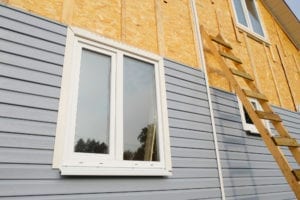
How Siding Impacts Energy Efficiency and Comfort in Your Home
When it comes to home improvement projects, siding might not always be the first thing that comes to mind. However, the siding on your home plays a crucial role in both energy efficiency and overall comfort. In addition to providing a protective barrier against the elements, the right siding can help regulate indoor temperatures, reduce energy consumption, and enhance the aesthetic appeal of your home. This comprehensive blog will delve into how siding impacts energy efficiency and comfort, the types of siding materials available, and tips for choosing the best siding for your needs.
Understanding the Role of Siding
Siding is the exterior material applied to the walls of a house to protect, insulate, and enhance its appearance. It serves as a shield against weather elements such as rain, snow, wind, and sun. Properly installed siding can prevent moisture infiltration, reduce heat loss or gain, and contribute to the overall durability of the home.
The Connection Between Siding and Energy Efficiency
Energy efficiency refers to the ability of a home to maintain a comfortable indoor temperature with minimal energy consumption. The right siding can significantly impact a home’s energy efficiency by providing insulation and reducing thermal bridging. Thermal bridging occurs when there is a direct pathway for heat to flow between the interior and exterior of a building, leading to energy loss.
Enhancing Home Comfort
Comfort in a home is largely influenced by its ability to maintain a stable indoor temperature, regulate humidity levels, and minimize drafts. High-quality siding can contribute to these factors by providing effective insulation and a tight seal against external elements.

Types of Siding and Their Impact on Energy Efficiency and Comfort
Vinyl Siding
- Overview: Vinyl siding is one of the most popular siding materials due to its affordability, low maintenance, and versatility. It is made from polyvinyl chloride (PVC) and comes in a variety of colors and textures.
- Impact on Energy Efficiency: Vinyl siding itself does not offer significant insulation. However, insulated vinyl siding, which has a layer of foam insulation attached to the back, can improve energy efficiency by reducing heat transfer and minimizing thermal bridging. This added insulation helps maintain a stable indoor temperature and reduces energy consumption.
- Impact on Comfort: Insulated vinyl siding can enhance home comfort by reducing drafts and maintaining a consistent indoor temperature. It also helps in dampening exterior noise, contributing to a quieter indoor environment.
Fiber Cement Siding
- Overview: Fiber cement siding is a durable and versatile material made from a mixture of cement, sand, and cellulose fibers. It is known for its resistance to fire, pests, and weather damage.
- Impact on Energy Efficiency: Fiber cement siding has moderate insulation properties and can be combined with additional insulation to improve energy efficiency. It effectively reduces thermal bridging and provides a sturdy barrier against weather elements, helping to maintain indoor temperatures.
- Impact on Comfort: The robust nature of fiber cement siding ensures a tight seal against drafts and moisture infiltration. This contributes to a more comfortable indoor environment by preventing cold drafts in winter and reducing heat gain in summer.
Wood Siding
- Overview: Wood siding offers a classic and natural look that can enhance the aesthetic appeal of any home. Common types of wood siding include cedar, redwood, and pine.
- Impact on Energy Efficiency: Wood siding has natural insulating properties that can help reduce heat transfer. However, its effectiveness depends on proper installation and maintenance. Wood siding can be combined with additional insulation to further improve energy efficiency.
- Impact on Comfort: Properly installed and maintained wood siding can enhance home comfort by providing effective insulation and reducing drafts. It also adds a warm and inviting feel to the home’s exterior.
Stucco Siding
- Overview: Stucco siding is a traditional material made from a mixture of cement, sand, and lime. It is applied in multiple layers to create a smooth and durable finish.
- Impact on Energy Efficiency: Stucco siding has moderate insulating properties and can be combined with additional insulation to enhance energy efficiency. It forms a solid barrier that reduces thermal bridging and helps maintain indoor temperatures.
- Impact on Comfort: The solid nature of stucco siding helps to minimize drafts and moisture infiltration, contributing to a comfortable indoor environment. It also provides sound insulation, reducing exterior noise levels.

Brick Siding
- Overview: Brick siding is a durable and long-lasting material known for its classic and timeless appearance. It is made from fired clay and can withstand various weather conditions.
- Impact on Energy Efficiency: Brick siding has excellent thermal mass properties, meaning it can absorb and store heat. This helps regulate indoor temperatures by reducing heat gain in summer and heat loss in winter. However, brick siding should be combined with additional insulation to maximize energy efficiency.
- Impact on Comfort: The thermal mass properties of brick siding contribute to a stable indoor temperature, enhancing home comfort. It also provides excellent sound insulation and a robust barrier against drafts and moisture.
Metal Siding
- Overview: Metal siding, typically made from aluminum or steel, offers a modern and industrial look. It is known for its durability, low maintenance, and resistance to pests and fire.
- Impact on Energy Efficiency: Metal siding has low insulating properties on its own, but it can be combined with additional insulation to improve energy efficiency. Reflective coatings can be applied to metal siding to reduce heat absorption and minimize cooling costs in warm climates.
- Impact on Comfort: With proper insulation, metal siding can help maintain a consistent indoor temperature and reduce drafts. Reflective coatings can enhance comfort in hot climates by keeping the home cooler.
Factors to Consider When Choosing Siding
Climate and Weather Conditions
The climate and weather conditions in your area should influence your choice of siding. For example, homes in hot climates may benefit from siding with reflective properties, while those in colder regions may require siding with high insulating values.
Insulation and Thermal Performance
Consider the insulating properties of the siding material and its ability to reduce thermal bridging. Insulated siding options or the addition of exterior insulation can significantly improve energy efficiency.
Maintenance and Durability
Choose siding that fits your maintenance preferences and offers long-term durability. Some materials, like vinyl and metal, require minimal maintenance, while others, like wood, need regular upkeep to maintain their appearance and performance.
Aesthetic Appeal
The appearance of your siding can greatly impact your home’s curb appeal. Select a material and style that complements your home’s architecture and enhances its visual appeal.
Cost and Return on Investment
Evaluate the cost of the siding material and installation, as well as the potential return on investment in terms of energy savings and increased home value. The cost of siding that is high-quality may have a higher upfront cost but can offer significant long-term benefits.

Tips for Improving Energy Efficiency with Siding
Add Exterior Insulation
Consider adding exterior insulation beneath your siding to enhance energy efficiency. This extra layer of insulation reduces thermal bridging, improves overall insulation, and contributes to a more stable indoor temperature.
Seal Gaps and Cracks
Ensure that your siding is properly installed and all gaps and cracks are sealed. Proper sealing prevents drafts, moisture infiltration, and energy loss, enhancing both energy efficiency and home comfort.
Choose Reflective Coatings
In hot climates, consider siding with reflective coatings that reduce heat absorption. Reflective coatings help keep your home cooler, reducing the need for air conditioning and lowering energy costs.
Regular Maintenance
Maintain your siding to ensure it continues to perform effectively. Regular cleaning, painting, and inspections can prevent issues such as moisture damage and drafts, preserving the insulating properties of your siding.
Upgrade Windows and Doors
Complement your siding upgrade with energy-efficient windows and doors. High-performance windows and doors reduce heat transfer and air leakage, enhancing the overall energy efficiency of your home.
The siding on your home plays a vital role in energy efficiency and comfort. By choosing the right siding material and ensuring proper installation, you can create a more energy-efficient and comfortable living environment. Consider factors such as climate, insulation properties, maintenance requirements, and aesthetic appeal when selecting siding for your home.
Investing in high-quality siding can lead to significant energy savings, improved indoor comfort, and increased home value. By taking steps to enhance the energy efficiency of your siding, you contribute to a more sustainable and cost-effective home that benefits both you and the environment. Whether you opt for vinyl, fiber cement, wood, stucco, brick, or metal siding, making informed choices will ensure your home remains efficient, comfortable, and beautiful for years to come.


Leave a Reply